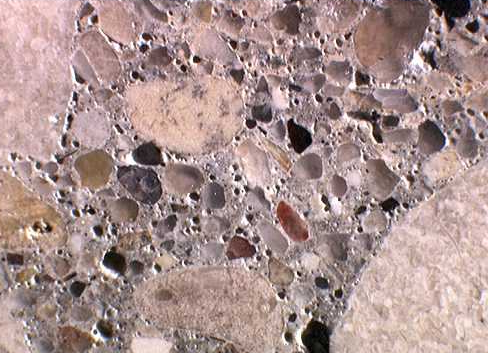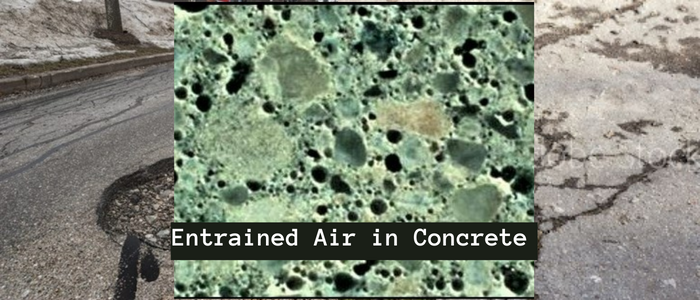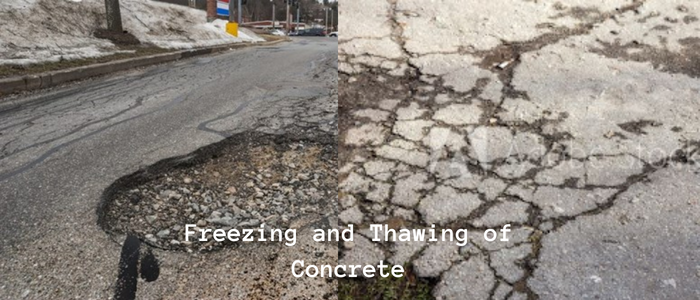In this article, we will shed the light on the air entrained concrete and how it is different from the normal Portland concrete, in addition to its properties.
What is Air Entrained Concrete?
Air Entrained Concrete is like the normal concrete but has an additional feature, which is the introduction of controlled amounts of air into concrete in the form of microscopic bubbles.

Note here that we add the air bubbles intentionally! and the way this is done is by using a certain type of admixtures (called air-entraining admixtures).
The size of the air bubbles is not constant; they are extremely small and range in size from a few thousandths of a centimeter in diameter to a few hundredths. But a very important feature of these air bubbles is that they are not connected to each other.
Literally, 1 cubic meter of air entrained concrete contains billions of air bubbles. These bubbles dramatically change the nature of both the fresh and hardened concrete.
In terms of shape, Concrete that has just been newly mixed with air entrained seems fatty out of the mixer. Cohesive and just a little bit sticky. It weighs somewhat less than concrete that has no air entrained because of these air bubbles. However, once it has hardened, it looks just like regular concrete.
So, the question now is how these additional air bubbles improve the properties of concrete?
How Entrained Air Improves Properties of Concrete?
Air bubbles makes higher workability and durability concrete that does not show excessive segregation and bleeding.
Effect of Air Entrainment on Fresh Concrete
We know that workability is the ease with which concrete can be moved and consolidated.
The air bubbles that we add behave as a “lubricant” that adds more plasticity and workability to concrete.
In addition to this, entrained air permits use of less water and sand in the concrete mixture.
Thus, of course, if you have a mix that is originally has low workability (harsh mix), you will be able to see the effect of adding air bubbles right away as the workability will increase.
Low workability due to other issues such as poor grading of aggregate can also be alleviated using the entrained air.
Segregation and excessive bleeding can also be decreased through the incorporation of entrained air.
If you are not familiar with the terms “segregation and bleeding”, we define them below:
Segregation: is the separation of coarse aggregate (gravel or crushed rocks) from the mortar (cement, sand, and water) in fresh concrete. As a result, we get non-uniform concrete.
Bleeding: is the term used to describe the appearance of water on the surface of freshly placed concrete slightly after casting.
Excessive bleeding (significant amounts of water on surface) happens when the water-cement ratio is high. By the way, this extra water when it reaches the surface, it increases the water-cement ratio of the surface layer and thus decreases its strength.
Bleeding also brings silt, clay and other nondurable materials all the way to the surface.
In summary, segregation and excessive bleeding are causes of many concrete defects and we need careful care to reduce them.
Air entrainment in the form of billions of disconnected air bubbles acts as a barrier layer to the movement of water from inside concrete to the surface, decreasing the development of capillaries or channels as a result. In turn, this lowers the likelihood that water will subsequently flow through the hardened concrete, resulting in a more waterproof concrete that lasts longer and requires less maintenance.
How about hardened concrete? How does air entrainment affect its properties?
Effect of Air Entrainment on Hardened Concrete
Two effects mainly happen:
The first one is the reduction in compressive strength. A negative effect
Why? Because at the end these bubbles are voids that fills the solid material and of course will reduce its density. In other words, the solid particles in concrete that will resist the load are less and hence, lower strength.
However, this reduction in strength can be alleviated be increasing the initial target strength from the beginning. Right?
The second effect, which is the reason we use entrained air in concrete, is that air entrainment increases the resistance of concrete to freeze-thaw damage and surface scaling caused by de-icing salts or chemicals.
To understand why this happens? Let us look at the mechanism of freezing-thawing damage.
Mechanism of freezing-thawing damage
Most concrete contains some moisture that comes from the initial mixing water or sometimes comes from external sources in the service environment of concrete such as ground water or sea water.
When concrete get exposed to freezing, the water inside its pores freezes and when this happens, if forms ice. The volume of the ice is higher than the volume of the liquid water by 9%.
So, here we have a situation: a constant volume of a pore and increase volume of ice. This extra volume does not have a space for it to fit. That is why it starts to push against the pore walls until pushing pressure exceeds the tensile strength of concrete. At this point, fracture of concrete occurs.
The following image shows how the freeze/thaw damage might look like.
How does Air Entrainment Improve the Resistance to Freezing/Thawing
So, now we know that without enough space for the volume growth of water, powerful pressures can emerge and tear the surface, leading to what is known as surface scaling.
Here comes the role of air entrainment.
These pressures are reduced by the tiny, entrained air bubbles, which act as reservoirs or expansion chambers. In other words, the air bubbles act as locations for the pressure relief.
For the air entrainment to be effective, the spacing and size of air bubbles are important.
Bubbles must be spaced not more than 0.25 millimeters apart throughout the cement paste and it is not difficult to obtain this bubble spacing.
What is percentage of Air Entrainment?
Let us look now at how much air should we use in concrete. Simply, the higher the air amount in concrete, the higher its resistance to freezing and thawing. Air contents are usually expressed in terms of percent air by volume of the concrete.
Typically, the percentage of air entrainment ranges from 3% to 8%. The exact value, however, depends on the mix design of concrete, which follows the code you are designing according to.
So, for example, the following table shows the values in ACI (American Concrete Institute) that should be used in concrete depending on the level of exposure to freezing and thawing, and aggregate size.

What happens is that you choose a certain value for air percentage in the design mix and then after you finish the design, you do trial batching to make sure that the amounts you designed for are the ones that you are obtaining. Otherwise, you will need adjustments.
Read on air content testing here
Generally speaking, air contents of 5 %, 6 % and 8% are generally considered optimum.
It may be necessary to design air entrained concrete for the upper limits of a given air content when concrete will be subjected to exceptionally harsh circumstances. Such situations could be present on city streets, sidewalks, curbs and gutters, bridge decks, loading platforms, and industrial roads where a lot of de-icers are utilized or where the air quantity may not be properly controlled.
When higher than optimum air contents are used, the possible effects on strength and on finishing should be considered.
Remember that air entrained concrete may be constructed for any strength, however in certain cases it might be required to slightly increase the cement content to retain the desired degree of strength.
The lower air content limitations are advised when entrained air is not necessary for protection against freezing and thawing and/or de-icers. For instance, 4 % entrained air can be employed when concrete is used in a building frame that is not exposed to the elements. Most of the advancements in transporting, casting, and surface texture are kept even with this less-than-optimal air content. When making concrete for floors that won’t be exposed to freeze-thaw cycles or de-icers, less-than-optimal air contents can be used.
Depending on the type of structure, the climatic conditions, the anticipated number of freezing and thawing cycles, the extent of exposure to de-icing chemicals, the presence of aggressive soils or waters, and to some extent the strength of concrete, the amount of air entrained in concrete should not be rigid but rather tailored to the specific need.
Where to use Entrained Air in Concrete?
All concrete exposed to freezing and thawing cycles is urged to employ entrained air, particularly in areas where de-icing agents will come into contact with the concrete.
Keep in mind that surface scaling can also occur as a result of de-icers being applied to concrete surfaces indirectly from sources like car underbody drips.
Whether or not removal of ice and snow with de-icing chemicals is planned, indirect application cannot be avoided, and air-entrained concrete should be used for all sidewalks, driveways, parking areas, garage slabs, etc., in freeze-thaw regions.
Given that de-icing agents are readily available in hardware, grocery, and drug shops, it is reasonable to predict that they will be applied on the majority of concrete in harsh climates.
Where all but a few commercially produced chemicals are used to remove snow and ice, well planned concrete pathways, roads, parking lots, etc. created with premium, well-consolidated, air-entrained concrete employing durable aggregates have no need for further protection.
The ice-removal products that include ammonium nitrate and ammonium sulphate salts are the exceptions. These substances are incredibly corrosive and will affect all types of concrete, including air-entrained concrete. Under no circumstances may they be used as de-icing agents.

